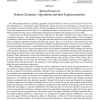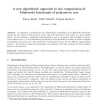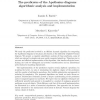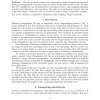126
click to vote
COMGEO
2006
ACM
15 years 1 months ago
2006
ACM
Predicting and optimizing the performance of ray shooting is a very important problem in computer graphics due to the severe computational demands of ray tracing and other applica...
121
click to vote
COMGEO
2006
ACM
15 years 1 months ago
2006
ACM
We present an approach for the exact and efficient computation of a cell in an arrangement of quadric surfaces. All calculations are based on exact rational algebraic methods and ...
143
click to vote
COMGEO
2006
ACM
15 years 1 months ago
2006
ACM
Geometric shortest paths are a major topic in computational geometry; see the survey paper by Mitchell [12]. A shortest path between two points in a simple polygon can be found in...
COMGEO
2006
ACM
15 years 1 months ago
2006
ACM
115
click to vote
COMGEO
2006
ACM
15 years 1 months ago
2006
ACM
Let S be a finite set of points in the plane and let T (S) be the set of intersection points between pairs of lines passing through any two points in S. We characterize all configu...
112
click to vote
COMGEO
2006
ACM
15 years 1 months ago
2006
ACM
An algorithm is proposed for the simultaneous computation of all Minkowski functionals (except for the volume) of sets from the convex ring in Rd discretized with respect to a give...
COMGEO
2006
ACM
15 years 1 months ago
2006
ACM
COMGEO
2006
ACM
15 years 1 months ago
2006
ACM
124
click to vote
COMGEO
2006
ACM
15 years 1 months ago
2006
ACM
: This note proposes a simple rule to determine a unique triangulation among all Delaunay triangulations of a planar point set, based on two preferred directions. We show that the ...





